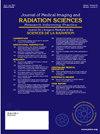对血液透析患者心外膜脂肪组织的心脏磁共振评估
IF 1.3
Q3 RADIOLOGY, NUCLEAR MEDICINE & MEDICAL IMAGING
Journal of Medical Imaging and Radiation Sciences
Pub Date : 2024-10-01
DOI:10.1016/j.jmir.2024.101532
引用次数: 0
摘要
背景心外膜脂肪组织(EAT)是普通人群心血管风险的预测指标。然而,EAT 在血液透析患者中的价值尚未得到充分验证。本研究旨在评估血液透析患者 EAT 与心脏结构和功能参数之间的相关性,并探讨 EAT 与透析年龄之间的关系。所有参与者均使用平衡稳态自由前序序列进行了心脏磁共振扫描。图像包括覆盖整个左心室的连续短轴切面、两腔、三腔和四腔切面。通过后处理软件获得心室功能参数和心外膜脂肪体积。在短轴切面上,从舒张末期左心室最顶端到基底水平划定 EAT。结果与健康志愿者相比,血液透析患者的 EAT 明显更高(40.7 ± 5.5 ml/m2 vs. 62.8 ± 17.3 ml/m2,P < 0.001)。EAT 与左心室收缩末期心肌质量指数(r = 0.59,P < 0.001)和左心室舒张末期心肌质量指数(r = 0.61,P < 0.001)呈正相关。EAT 与左心室整体径向应变呈负相关(r = -0.33,P = 0.038)。EAT与血液透析年龄(P = 0.587)、左室射血分数(P = 0.086)、右室射血分数(P = 0.331)之间无明显相关性。EAT与心肌质量和整体径向应变有明显相关性。需要进一步研究评估 EAT 在预测血液透析患者心血管事件方面的价值。本文章由计算机程序翻译,如有差异,请以英文原文为准。
Cardiac magnetic resonance evaluation of epicardial adipose tissue in hemodialysis patients
Background
Epicardial adipose tissue (EAT) is a predictor of cardiovascular risk in the general population. However, the value of EAT in hemodialysis patients has not been fully validated. The aim of this study was to evaluate the correlation between EAT and cardiac structure and function parameters in hemodialysis patients, and to explore the relationship between EAT and dialysis age.
Methods
Forty patients with chronic kidney disease undergoing regular hemodialysis and five healthy volunteers were enrolled prospectively. All participants underwent cardiac magnetic resonance scanning using balanced steady-state free precession sequence. Images included continuous short-axis views covering the entire left ventricle, two-, three- and four-chamber views. Ventricular function parameters and epicardial fat volume were obtained by post-processing software. On the short-axis cine stack, EAT was delineated from the most apical to basal level of left ventricle at end-diastole. Fat volume was calculated by modified Simpson's rule, with body surface area corrected for individual differences.
Results
Compared with healthy volunteers, EAT in hemodialysis patients was significantly higher (40.7 ± 5.5 ml/m2 vs. 62.8 ± 17.3 ml/m2, P < 0.001). EAT was positively correlated with left ventricular end-systolic myocardial mass index (r = 0.59, P < 0.001) and left ventricular end-diastolic myocardial mass index (r = 0.61, P < 0.001). There was a negative correlation between EAT and left ventricular global radial strain (r = −0.33, P = 0.038). There was no significant correlation between EAT and hemodialysis age (P = 0.587), left ventricular ejection fraction (P = 0.086), right ventricular ejection fraction (P = 0.331).
Conclusions
Hemodialysis patients have more EAT. EAT was significantly correlated with myocardial mass and global radial strain. Further studies are needed to evaluate the value of EAT in predicting cardiovascular events in hemodialysis patients.
求助全文
通过发布文献求助,成功后即可免费获取论文全文。
去求助
来源期刊

Journal of Medical Imaging and Radiation Sciences
RADIOLOGY, NUCLEAR MEDICINE & MEDICAL IMAGING-
CiteScore
2.30
自引率
11.10%
发文量
231
审稿时长
53 days
期刊介绍:
Journal of Medical Imaging and Radiation Sciences is the official peer-reviewed journal of the Canadian Association of Medical Radiation Technologists. This journal is published four times a year and is circulated to approximately 11,000 medical radiation technologists, libraries and radiology departments throughout Canada, the United States and overseas. The Journal publishes articles on recent research, new technology and techniques, professional practices, technologists viewpoints as well as relevant book reviews.
 求助内容:
求助内容: 应助结果提醒方式:
应助结果提醒方式:


